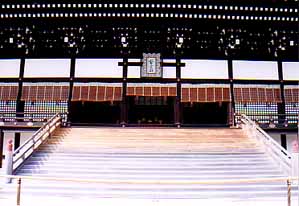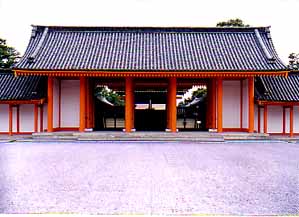
| Main Page |
| Photo Galleries |
| Writing |
| Aikido |
| Zen |
| Peeps |
| Links |
| Contact |
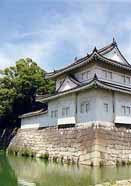

Kyoto Imperial Palace
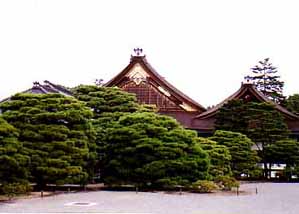 Kyoto
was home to the Imperial court for over 1000 years, until the capital
was moved to Tokyo during the Edo Period. The Imperial Palace was first
built in 794, but like so many of the ancient structures here, was ravaged
repeatedly by fires throughout the ages.
Kyoto
was home to the Imperial court for over 1000 years, until the capital
was moved to Tokyo during the Edo Period. The Imperial Palace was first
built in 794, but like so many of the ancient structures here, was ravaged
repeatedly by fires throughout the ages.
The current structure was built in 1855, and although the buildings are no longer used by the Imperial Family, the Palace is still used during enthronement ceremonies.
|
|
|
Security is fairly tight at the Palace, and unlike most historical sites where you can stroll about and see everything at your leisure, you must register your passport and apply for permission to join one of the guided tours of the Palace.
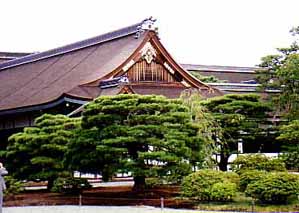 One of the main buildings in the Imperial Palace with its vaulted roof and metal embellishments. The entire Palace is made up of single story buildings in the traditional style. |
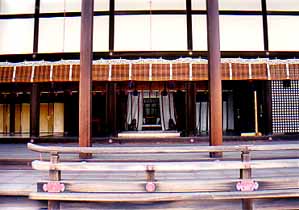 An audience area for the Emperor. A small throne lies nestled behind the curtains inside, and again, there are bamboo screens that can be lowered to shelter the Emperor from the eyes of lesser beings. |
The Imperial Palace lies amid a massive expanse of parkland that is directly in the middle of Kyoto. Although the city now sprawls out as much as the surrounding mountans will allow, it was once centred on the Palace itself. The result is a surprisingly large spread of trees and pathways in what must be the most valuable real estate in the city.
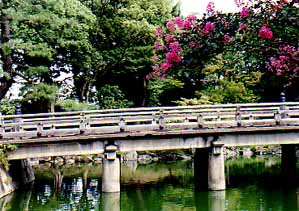 An old walking bridge spans the pond that surrounds a small teahouse located within the Imperial Palace Park. |
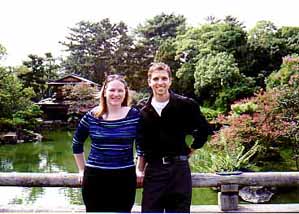 Laura and I on the bridge with the teahouse in the background. |
The Imperial Palace also play host to a number of events and festivals throughout the year, the most significant of which is October's Jidai Matsuri which is one of Kyoto's big three festivals.
The Palace buildings themselves are nestled in behind high, protective walls that shield them from view until you are admitted into the compound. Once inside, though, one is able to see the full beauty of the Palace grounds. That being said, however, one of the most striking things about the palace was the understated charm of the place. Far from being gaudy displays of the wealth and power of the Emporer, the Palace is made up of the same low slung buildings that were typical of that age.
The most captivating parts of the tour, for me, were the gardens that surrounded the Palace buildings. As it was so difficult for the Emporer and the members of his court to travel, the gardens of the Palace were meant to simulate different aspects of the countryside. The results are spectacular representations of beaches, forests and lakes all blended seemlessly together so as to appear almost completely natural.
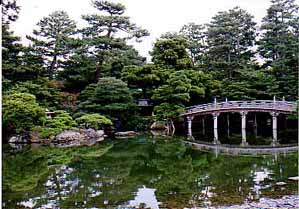 |
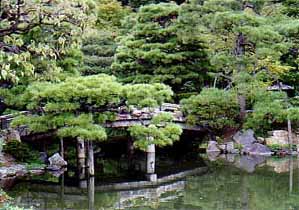 |
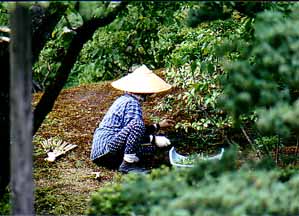 |
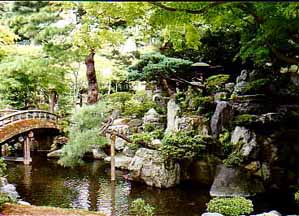 |
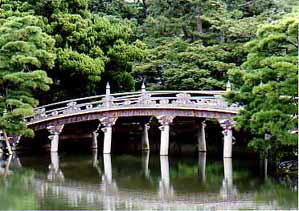 Styled to resemble the coutryside that was beyond the reach of the courtiers, the gardens of the Imperial Palace are a sight to behold. Maintained by an army of gardeners who toiled away even as we strolled though the grounds, these gardens show off the skill of the Master gardeners that designed them. |
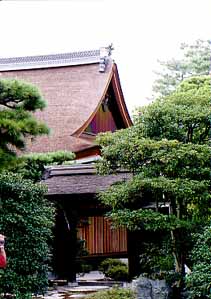 |
